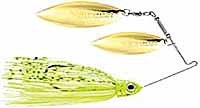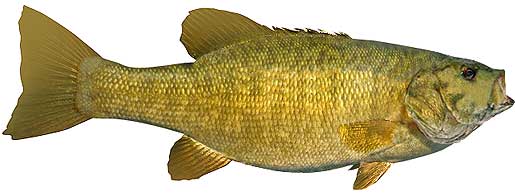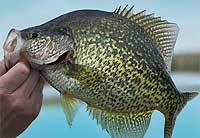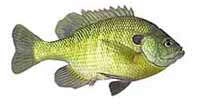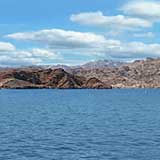Fishing Report For Lake Mohave, AZ
By Rick Seaman
September 12, 2025
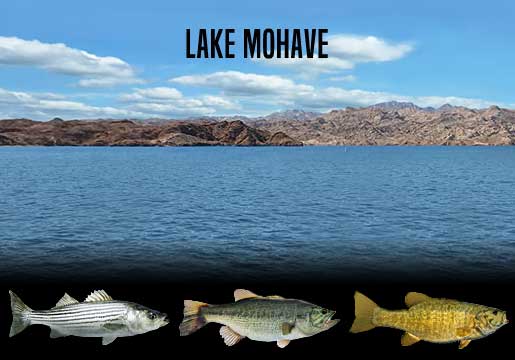
Fishing Reports
Popular Fish Species Lake Mohave, AZ
Striped Bass
Current Report: Good To Very Good
FALL. In Fall, stripers are drawn back to the shallows, as well as the upper end of the lake into inflowing water. Look for deeper sections in the upper river channels, and fish them thoroughly. Tailwaters from the Hoover Dam hold healthy concentrations of fish, and it is a popular spot for occasionally catching big stripers.
WINTER. In Winter, stripers again hang out in deeper water and feed close to the bottom, often as deep as 80 feet. Warm, sunny afternoons occasionally draw stripers shallower, to around 20 or 30 feet deep as they feed on roaming schools of threadfin shad. Locate schools of bait, then look for stripers close by. Fish finders, and forward facing sonar, are a big help in locating these roaming schools. Nice stripers are caught while drift fishing with live bait or cut bait. Spoons, blade baits, and heavy hair jigs are also effective this time of year. Due to the stripers slower metabolism this time of year, anglers are triggering more strikes by working baits more slowly.
SPRING. Water temperatures are return to the mid 60's, and that's ideal for the stripers to spawn. The lake record is over 60 pounds, and many anglers believe there are bigger ones to be caught. The lake is loaded with stripers averaging 2 to 6 pounds, with plenty of 10 pound plus fish being caught. In Spring, work the upper end of the lake where there is inflowing water, especially in the tailwaters of Hoover Dam. If they spawn, this is where they will lay eggs in the flowing water. Look for deeper holes in the river channels, as they are a good holding place for stripers.
SUMMER. In Summer, stripers hang out in deeper water during the heat of the day and feed close to the bottom, 60 or 80 feet deep, or deeper. Morning often draws the stripers to much shallower water, so look for them around the 25 to 50-foot range as they feed on shallow, roaming schools of threadfin shad. Being successful at fishing for stripers in Summer is a matter of locating schools of bait, and the wolf packs of stripers are likely to be nearby. Fish finders, and sonar electronics, are a big help in locating these roaming schools. Nice stripers are being caught while trolling or drift fishing. Spoons, blade baits, crankbaits, live bait and cut bait are all effective here.
Largemouth Bass
Current Report:Good To Very Good
FALL. Now that Fall has arrived, bass here are moving shallow and following schools of baitfish into coves and shallow bays into 5 to 15 feet of water. Currently topwater, jerkbaits, crankbaits, and finesse baits are catching most of the bass. Later in Fall, as deeper water cools, bait and bass move out to ledges, channel edges, points and humps where drop shots, flutter spoons and jigs are often good choices.
WINTER. Winter will drive bass around deeper structure, points and creek channels. They can be found from 20 to 50 feet deep, or deeper. Here they hold, feeding less frequently, awaiting warmer water to return in Spring.
SPRING. Once water temperatures rise into the low 60's, largemouth will move from deep wintering holes, to shallower water nearby spawning areas. Vibrating jigs, jerkbaits and spinnerbaits typically get bites just away from the shoreline. At this time they are feeding aggressively and preparing for the spawn. Once water warms into the mid to high 60's, they will move into 1 to 4 feet of water, and create nests, then lay their eggs. Immediately afterwards, females move to deeper water and males remain to guard the eggs, and then the fry. After a couple weeks, the males also move to slightly deeper water. Crankbaits, vibrating jigs, plastic worms and swimbaits are catching bass during this period.
SUMMER. Water temperatures will warm considerably in Summer. Bass will feed shallow, early and late in the day, where they will be caught on topwater, crankbaits, jerkbaits and swimbaits. Wacky-rigged stick worms always catch finicky bass when the bite is slow. Largemouth bass here feed on threadfin shad, small sunfish and crawfish. During the hotter parts of the day, they are being caught on points, channel edges, and ledges 15 to 45 feet deep.
Smallmouth Bass
Current Report: Good To Very Good
FALL. Now that Fall is here, smallmouth are following schools of baitfish into coves and bays, where tube baits, drop-shots, and jerkbaits, are successful. The average fish being caught averages about 2 pounds, but plenty of 3 to 5 pound smallies are being caught. Fishing shallow for smallmouth is often good on cold, windy, cloudy and rainy days. Later in Fall smallies move to 15 to 30 foot water on points and ledges, where Ned rigs, tube baits, drop shots and flutter spoons work well.
WINTER. Winter will isolate them around deeper structure, points and creek channels, often suspending in open water above these features. They can generally be found from 20 to 50 feet deep. Here they hold, feeding less frequently, awaiting warmer water to return in Spring.
SPRING. When water temperatures rise into the 50's, smallmouth have moved from deep wintering spots, to shallower water, just outside spawning areas. They feed heavily at this time, and are typically caught on jerkbaits, crankbaits, tube baits, Ned rigs, and crayfish imitating plastics. They will be preparing for the spawn. Once water warms into the low 60's, they move into shallower water, and create nests in gravel or sandy areas, then lay their eggs. After spawning, females move to deeper water while males remain to guard the eggs, and then the fry. After a couple weeks, the males also move to slightly deeper water and feed aggressively. Crankbaits, tube baits, Ned rigs, plastic worms, spoons and swimbaits catch smallies during this period.
SUMMER. Smallmouth bass begin feeding shallow, early and late in the day, where they are being caught on topwater, crankbaits, swimbaits, Ned rigs and tube baits. Smallmouth bass here feed on crawfish, threadfin shad, and small sunfish. They prefer rocky or gravel bottom areas, as this is where crayfish live. During the hotter parts of the day, they are being caught on points, humps, and ledges 10 to 45 feet deep. Often these deeper fish are part of a school of smallmouth.
Fishing Video
Fish species to fish for...
Guide to fishing for smallmouth bass, largemouth bass, channel catfish, black crappie, rainbow trout, bluegill and striped bass at Lake Mohave in Arizona.

Lake Mohave is a 28,800-acre reservoir with over 200 miles of shoreline. Striped bass, largemouth bass, smallmouth bass, trout, catfish, and panfish provide a nice variety of fishing options. There is extremely limited options for fishing from the bank.
Primary fish species to catch
Click images for fishing tips and details about each species.
Today's Weather & Forecast
(Weather at Katherine Landing)
Fishing Boat Rentals
Click here for fishing boat rentals.
Marinas
Click here for marinas.
Boat Launch Ramps & Landings
Click here for boat ramps.
Fishing License
Click here for a Arizona Fishing License.
Click here for a Nevada Fishing License.
Map - Fishing & Access
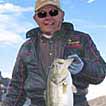
Rick Seaman is a fishing enthusiast with over five decades of fishing experience, a retired tournament fisherman, author of numerous published articles on fishing, and co-author of the book "Bass Fishing - It's not WHAT you throw, It's WHERE you throw it".
Contact Information
Arizona Side
Lake Mohave Marina
2690 Katherine Spur
Bullhead City, AZ 86429
928 754-3245
Nevada Side
Cottonwood Cove Resort & Marina
10000 Cottonwood Cove Rd
Searchlight, NV 89046
702 297-1464
Fishing lakes in each state
091225
Lake Mohave, Arizona Report
ARIZONA



Information about camping and fishing lakes in AZ.
Mohave Lake, along the Arizona border, offers great fishing plus boat, jet ski, pontoon boat and houseboat rentals.














